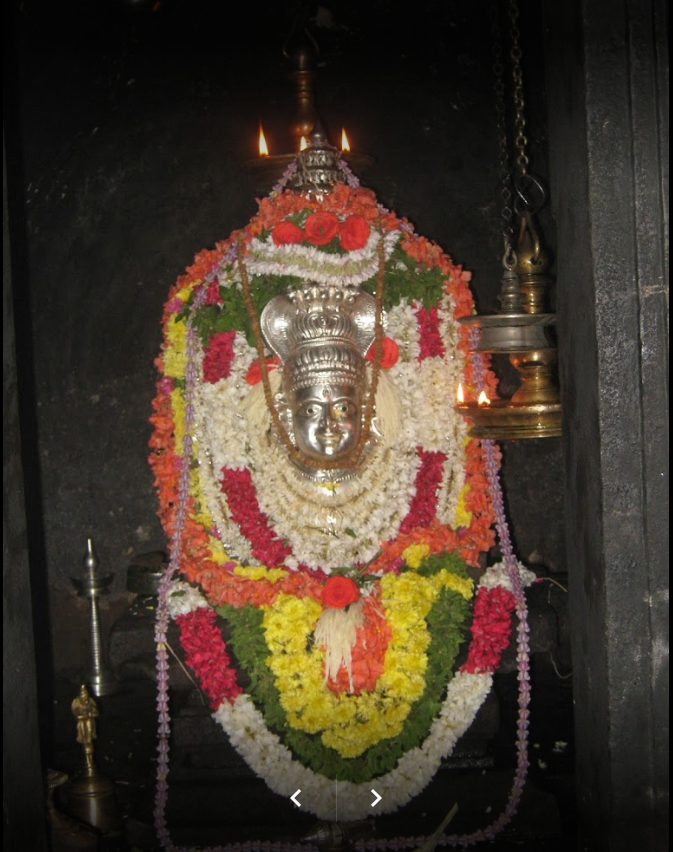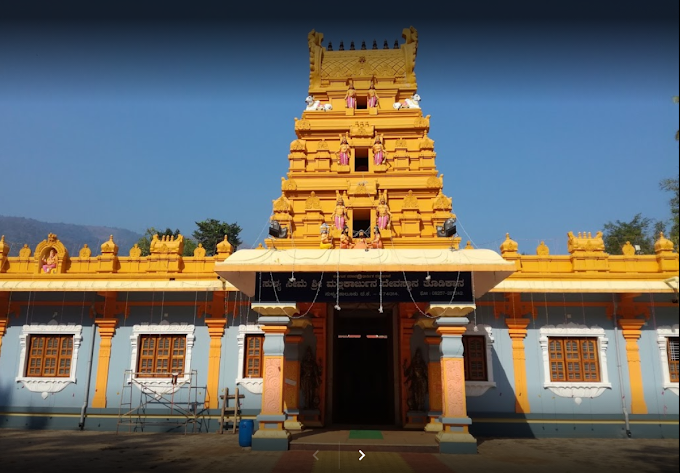Temple
The temple is three-storeyed. In the lowest middle and uppermost parts are
respectively installed the lingams of Mahakalesvara, Omkaresvara and Nagachandresvara.
The pilgrims and the visitors can only have the glimse of Nagachandresvara on the festive
of Naga Panchami. A very large-sized Kunda named Koti Tirtha also exists in the
temple-complex. The Kunda is built in the sarvatobhadra style. The Kunda and its water
both are treated as very celestial. On the path adjoining the stairs of the Kunda, may be
seen many images representing the sculptural grandeur of the temple built during the
Paramara period. In the east of the Kunda is a large-sized Veranda in which there is the
entrance to the path leading to the garbhagrha. In the northern side of the verandah, in a
cell, the images of Sri Rama and goddess Avantika are worshipped. In the southern side
of the main shrine, there stand many small Saivite temples built during the shinde
regime among these the temple of Vrddha Mahakalesvara, Anadi Kalpesvara and
Saptarshi are prominent and are the remarkable pieces of architecture.
The lingam of Mahakalesvara is colossus. The silver plated Naga Jaladhari and the
inscribed and esoteric silver-plate covering the roof of the garbhagrha add extra grandeur
to the shrine. Besides Jyotirlinga, attractive and small-sized images of Ganesa, Kartikeya
and Paravati can be seen in the garbhagrha. All around the walls classical eulogies in the
praise of Lord Siva are exhibited. The Nanda Dipa always remains lit. In the exit-path, there
is a wide hall in which a most attractive metal quoted stone Nandi, in the sitting humble
pose may be witnessed. The courtyard just opposite to the Omkaresvara temple add
much to the magnanimity of the temple-complex. Just adjoining to this temple, there are
two pillared projections facing the east and adding a lot to the architecture of the temple.
The temple of Mahakalesvara is a planned admixture of the Bhumija, Chalukya and
Maratha styles of architecture. The sikhara with the mini-srngas is very peculiar. In previous
years its upper part has been covered with gold plate.
As seen earlier, the present temple of Mahakala was built during the 4th – 5th decades
of Eighteenth c. Simultaneously the religious-minded nobles of Maratha community
also built many a temples in the temple-complex. During this period many ancient
traditions such as worship abhisheka, arati, sawari (procession) in the Sravana month,
Harihara-milana etc, were also revived. These are still continuing with joyful ceremony
and devotional enthusiasm. The Bhasmarti in early morning, Mahasivaratri, Pancha-Krosi
Yatra, Somavati Amavasya etc. are special religious occasions interwoven with the rituals
of the temple. Proper repairs and rejuvanation of the temple-complex is done at the time
of the Kumbha Parva. In the year 1980, a separate mandapam was constructed to facilitate
the visitors. In 1992, Madhya Pradesh Government and Ujjain Development Authority
exclusively contributed special repairs and made provisions for the stay of pilgrims. The
same process is also being followed at the time of the forthcoming Simhastha.
History
When did the Mahakala temple first come in existence, is difficult to tell. However,
the event may be assigned to the Pre-historic period. Puranas narrate that it was
first established by Prajapita Brahma. There is reference to the appointment of
prince Kumarasena by king Chanda Pradyota in 6th c. BC for looking after the law
and order situations of Mahakala temple. The punch-marked coins of Ujjain,
belonging to 4th-3rd c. BC, bear the figure of Lord Siva on them. Mahakala
temple is also mentioned in several ancient Indian poetic texts. According to
these texts, the temple had been very magnificent and magnanimous. Its
foundation and platform were built of stones. The temple rested on the wooden
pillars. There had been no sikharas on the temples prior to the Gupta period.
The roofs of temples had mostly been flat. Possibly due to this fact, Kalidasa
in Raghuvansam described this temple as ‘Niketana’. The palace of the king had
been in the vicinity of the temple. In the early part of the Meghadutam
(Purva Megha), Kalidasa gives a fascinating description of the Mahakala temple.
It appears that this Chandisvara temple might have been a unique example of
the then art and architecture. It may be ascertained that how splendid had been
the temple of the main Deity of that town which possessed multi-storeyed gold-plated
palaces and buildings and the superb artistic grandeur. The temple was enclosed by
high ramparts attached with the entry-gates. At twilight the lively rows of glittering
lamps enlightened the temple-complex.
The whole atmosphere echoed with the sound of various musical instruments.
The whole atmosphere echoed with the sound of various musical instruments.
Thecharming and well-decorated damsels added a lot in the aesthetic beauty of
the temple. The echo of the Jaya-dhvani (Let the Lord be victories) of the assembly
of the devotees was heard far and wide. Priests remained busy in worshipping the
Deity and chanting eulogies. The Vedic hymns were recited and Stutis were sung,
the painted walls and well-carved images projected the artistic heights of the day.
After the downfall of the Gupta empire, several dynasties including the Maitrakas,
After the downfall of the Gupta empire, several dynasties including the Maitrakas,
Chalukyas, Later Guptas, Kalachuris, Pusyabhutis, Gurjara Pratiharas, Rastrakutas etc.
dominated the political scenerio in Ujjain one after the other. However, all bowed down
before Mahakala and distributed endowments and alms to the deserving. During this period
a number of temples of various gods and goddesses,Tirthas, Kundas, Vapis and gardens
took shape in Avantika. Several Saivite temples including those of 84 Mahadevas existed
here. This fact should specifically be underlined that when every nook and corner of
Ujjain was dominated by religious monuments housed by the images of their respective
deities, the development and progress of Mahakala temple and its religiocultural milieu
was not at all neglected. Among many of the poetic texts composed during this period,
which sung the significance and glamour of the temple, Harsacharit and Kadambari of
Banabhatta, Naisadhacharit of Sri Harsa, and Navasahasamkacharit of Padmagupta are
noteworthy. It so appears that during rhw Paramara period, a series of crisis prevailed over
Ujjain and the Mahakala temple. In the Eighth decade of Eleventh c. AD, one
Gazanavide commander invaded Malwa, looted it brutally and destroyed many temples
and images. But very soon the Paramaras rejuvenated every thing. A contemporary
Mahakala Inscription testifies the fact that during the later Eleventh c. and early twelfth
c., the Mahakala temple was re-built during the reign of Udayaditya and Naravarman.
It was built in the Bhumija style of architecture, very favourite to the Paramaras. Remains
available in the temple-complex and the neighbouring places authenticate this fact.
The temples of this style had been either Triratha or Pancharatha in plan. The main feature
of identification of such temples had been its star-shaped plan and the sikhara. So
far as the sikhara is concerned, urusrngas (mini-spires), generally of odd numbers,
gradually decreasing in size in rows between the well-decorated spines (haravali or lata)
rose up at the cardinal points from the Chityaas and the Sukanasas ultimately
surmounted by the Amalaka. Every part of the temple was glutted with decorative motifs
or images. Horizontally, the shrine from front to back was respectively divided in
entrance, ardhamandapa, sanctum, antarala (vestibule) garbhagrha and Pradaksanapatha.
Upper components of the temple rested on the strong and well-designed pillars and pilasters.
Such temples, according to the contemporary Silpa-sastras contained the images of various god
and goddesses, Nava Grahas (Nine planets), Apsaras (celestial damsels), female dancers,
anucharas (attendants), Kichakas etc. The sculptural art of the temple had been very
classical andmultifarious. Besides the Saivite images of Nataraja, Kalyanasundara,
Ravananugraha, Gajantaka, Sadasiva, Andhakasura-slayer, Lakulisa etc., the temples
were adorned with the images of Ganesa, Paravati, Brahma, Visnu, Surya (Sun-god),
Sapta Matrkas (Seven mother-goddesses) etc. These images had been very
proportionate, well-decorated, sculpturally perfect and carved according to classical and
Puranic texts. The worshipping and the conduct of rituals continued in some way or
the other. Prabandha Chintamani, Vividha Tirtha Kalpataru, Prabandha Kosha all composed
during 13th-14th c. reveal this fact. Similar mention is made in Vikramacharit and
Bhojacharita composed in 15th c. AD. According to the epic Hammira Mahakavya,
Hammira, the ruler of Ranathambor worshipped Lord Mahakala while his stay in Ujjain.
A few Sanads issued by the Sultans of Malwa and Mughal emperors have come to light
in Ujjain which testifies that during the mediaeval period these Islamic rulers contributed
some donations to priests for conducting worship, lighting the lamps and offering the
prayers to Divinity for the safety of their reign. Thus it is evident that these Islamic
rulers also had a respect for Mahakalesvara and they issued financial assistance for the
appeasement of Hindu subjects too. Maratha regime was established in Ujjain in the
fourth decade of Eighteenth c. The administration of Ujjain was assigned by Peshwa
Bajirao-I to his faithful commander Ranoji Shinde, The diwan of Ranoji was Sukhatanakar
Ramchandra Baba Shenavi who was very wealthy but unluckily issueless. On the suggestions
of many learned Panditas and wel-wishers, he decided to invest his wealth for religious
purposes. In this connection, he re-built the famous Mahakala temple in Ujjain during the
4th-5th decades of Eighteenth c. AD.
Contact
| President - Shree Mahakaleshwar Temple Management Committee,Ujjain. | ||||
| Office: 0734-2550563 Administrator - Shree Mahakaleshwar Temple Management Committee,Ujjain. Off Tel 0734-2550563
|















